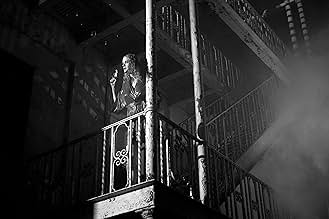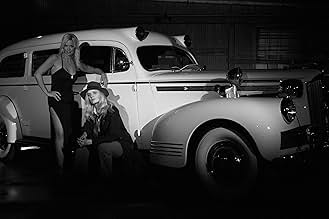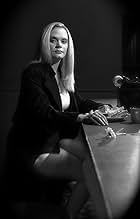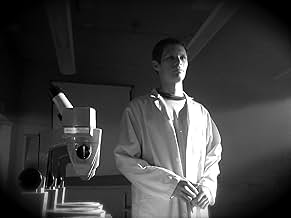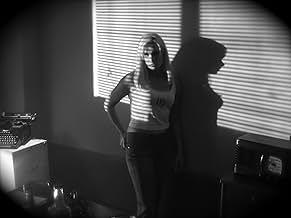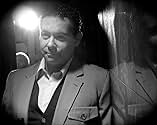Agrega una trama en tu idiomaHoyle, a girl with a sharp mind and a weakness for bourbon, finds herself on the trail of a reclusive genius. But her work takes a series of unforeseen twists as events around her grow incre... Leer todoHoyle, a girl with a sharp mind and a weakness for bourbon, finds herself on the trail of a reclusive genius. But her work takes a series of unforeseen twists as events around her grow increasingly fragmented... disconnected... surreal. With an ethereal lounge singer and her loya... Leer todoHoyle, a girl with a sharp mind and a weakness for bourbon, finds herself on the trail of a reclusive genius. But her work takes a series of unforeseen twists as events around her grow increasingly fragmented... disconnected... surreal. With an ethereal lounge singer and her loyal partner as her only allies, Hoyle is plunged into a dark world of intrigue and earth-sha... Leer todo
- Dirección
- Guionista
- Elenco
- Premios
- 11 premios ganados en total
- Bartender
- (as Joe Leroy Reynolds Jr.)
- Dirección
- Guionista
- Todo el elenco y el equipo
- Producción, taquilla y más en IMDbPro
Opiniones destacadas
This is a strange movie.., maybe not in the usual sense, like a Dark City, or Bladerunner or even a host of mediocre, time-bending, sci-fi films like The Fare.., possibly because this film's primary purpose was not actually to be a movie in the first place.....imho. (stay with me)
I see James Kerwin as a remarkably talented fellow. But like the movie's male lead, Dudas.., some femme fatale broke his heart. And, at the point where his world was crumbling and time had stopped.., Kerwin had a choice to either join a MGTOW forum on YouTube (swear off wimmen for good).. or use his anguish to make a film-noir adaptation of his painful odyssey.., possibly with the hidden, albeit semi-predictable agenda of winning HER back. He chose the latter., foolish boy.
And you could say he really put his heart into it - striving, it would seem, for actual cinematic excellence (trial by theater), and revealing himself to be a sort of vanishing old-school Hollywood type, nostalgic of course, and aiming for production effects from the glory days of Hollywood, as opposed to the current, cold, calculating Cyclops of Baloneywood, bent on agenda-driven, formulaic films and even more formulaic propaganda. One might even call him a rebel (ergo of no use to the Masons).., perhaps accounting for his having only made this one solitary movie, despite his obvious skills and passion.
Dare I say, because catharsis and solace for Kerwin's broken heart were the raison detre of this film, several commonplace areas of production might have been slightly neglected - say, plot.. being the foremost. While some reviewers contend there actually is a plot.., I would not go THAT far. Furthermore, the absence of plot didn't really bother me. Besides which, I HAD been warned.., by an opening credit for one of the production companies, which boldly claimed it produced "intelligent films". So, no surprises.
I never really felt like the film was about telling a story anyway. Dare I suggest.., (for me) it was a kind of a (serene) visual and emotional hypnosis, where I was compelled to enter their world, by dint of the actors' commitment to the whole experience. In other words, Kerwin yet again expressed his unique values by selecting actors who were also "old school" -- drawn to acting, not to escape reality by treading the boards.., but to either escape the general phoniness of the "real" world, or perhaps their own personal sense of Unreality -- people who had perhaps always struggled to find their true inner identity, as might often be thought the case with individuals tortured by gender-identity issues.. or who merely longed to be some best, most beautiful version of themselves. (Think Melanie Griffith.., who exultantly "found herself in Forever Lulu.. (imho).
Take Chase Masterson for example - who, if you soberly peruse web images and so forth, might come across as bat-suit crazy.. and not even terribly attractive (or even female); but somehow Chase was absolutely dazzling, as if he/she'd matriculated from a life of endless beaus and beauty pageants, and had been literally carried from Edina to Hollywood.. on the shoulders of her worshipful admirers and understudies. She finally caught it!!
Kenleigh Brown.., well, unless simply a very adept switch-hitter.. was possibly more the former circumstance, tortured by his/her inner anima longing to be female.., but instead of projecting it onto some teenage inamorato, decided to BECOME said anima.., nevermind the Kirk Douglas chin or masculine brow ridges. (These are things you pick up being MGTOW.) Her acting, as well, was a bit ambivalent, and things did get off to a rather slow start.., but, imho, once the actors started trusting each other (getting comfortable with their collective schizophrenia).., some of Kenleigh's acting moments were astonishing and quite beautiful.., almost as if knowing their film tribute to this classic vision of Acting might be the last vestige of a dying art. (Wrap it up, buddy.)
Throw in a lot of semi-intriguing vocabulary from the world of arcane psychology and basically irrelevant metaphysics and pseudoscience.. (which the viewer cannot question, lest they appear stupid).., and voila - an 'omage to the naive and floundering past.. and all bittersweet human glories unattainable - electrically-crackling, star-crossed romance and abiding love, where wimmen are not fickle and hypergamous, or seeking self gratification by a juggernaut process of trial and error, where eviscerating collateral damage is NOT a given.
In short.., if you like antiques and/or at least drive a PT Cruiser, you'll probably enjoy this film.. despite its lack of plot or utile wisdom.., though a couple Manhattans ahead of time probably wouldn't hurt. AND, ere parting.. with a painfully slow shuffle about the dance floor -- I can't and shouldn't omit fierce kudos to (now deceased) Mik Scriba, who played Hoyle's somewhat inexplicable but uncondescending sidekick. Very endearing.
cheers!!😇 (I am not entirely discounting the possibility that they serve Manhattans in heaven.)
Short form, if you've seen other films noir, you've seen this one, except done better. If you've seen a lot of film noir, you've seen everything in this one, because it seems to be little more than a visual mash-up of what's been done before.
That in itself is bad enough, but the acting and the writing are atrocious. If you saw Super 8, at the end of the film you get the see the project film that all the kids are working on throughout the movie. "Yesterday was a Lie" is very slightly better than that. Given that the writer is also the director, and based on the fact that every performance is flat and fails to engage, I think the direction must also be at fault.
There is philosophy to be found here. I would urge you to read up on mysticism and physics (particularly quantum mechanics) instead of spending your time on this movie. You'll learn a lot more, and in the end you will have spent your time more wisely.
This film was originally shot in color and then desaturated in post production. The black and white or "noir" aspect of the film adds its own personality. Color would not have worked for this film because it has a 1940-1950's "Bogart" theme to it. You see Hoyle play the part of the investigator playing the part of the crime detective so well. She plays it as a female; which no doubt, offers a refreshing way to see a detective role played.
The convention I attended was the first Con for me. When I saw the Films listed I read more about this film and it looked very interesting. It met and beat all my expectations. I had the chance to meet Chase Masterson playing the Singer and Director James Kerwin. There was a great panel on the film and many questions were answered. Take a look at the cast and you will notice some familiar faces in the Sci-Fi family.
If I could only see this film in the area again or buy a DVD I would! See it for free while you can!
Have an open mind and see it at a convention or festival now!
The film exemplifies Godard's maxim that all it takes to make a movie is a girl and a gun. In this case the lead female characters are two lovely blondes. Each so cleverly resembles the other that one is reminded of Discreet Object of Desire, the surrealist flick where two actresses played one character.
But adding layers of complexity here, these twin-like actresses are also playing the left and right sides of the brain of the feminine anima of one male character. Got that? They all meet at the Pigeon Hole lounge. The first character is the young Hoyle, a feminine Bogart/Sam Spade analytic detective - the left brain. Like Sam she likes the gin and the story straight. The second is a sultry, un-named singer who has a familiarity with the poetics of T.S. Eliot - the brain's right. Her music is entrancing, her wit intuitive and nonlinear. Together, these two provide the counterpoint of Jung's anima to the male animus of the main character, Dudas.
Whether Hoyle and her counterpart, Singer, convince us they are our anima is irrelevant as we so want them to be part of us. These lovelies draw us ever so seductively into imagining the dark recesses of our own beautiful unconscious, despite whatever misgivings. All we're here for is love, we are told. The shape of the universe is a relationship - functional or otherwise - whether with our inner parts or with our fellow beings. This makes for a strange little Jungian romp in luscious b&w footage. This is Lynch with an underlying premise. Somewhat like the film Pi, this low budget beauty was made at the cost of Pi (made at $60,000) times pi!
First time director James Kerwin makes for a Jungian fortune teller taking us on a trip to disentangle or re-entangle our male and female halves. Kerwin is an urban shaman who shows us the conventional mind as a "surge suppressor". Our conscious minds filter small broken bits of time in a lame attempt to tell a story. Does it matter whether they "add up"?
Beginning with some obvious allegory, the locks are broken off the allegorical unconscious and our character, curiously named Hoyle bravely walks into a poetic film noir journey to confront the Self. (Hoyle seems named after transcendental astronomer/physicist Fred Hoyle who was deeply intrigued by the "Anthropic Principle" of nature.) We begin with a look at Dali's surrealist masterpiece Persistence of Memory in a hallway. They meet Schrödinger's cat, the parable of which tells us there are opposite angles on everything and only by choosing do we arrives at any definitive perspective. Free Will is discussed. The film reveals a Jungian Fenestra Aeternitatus, a window to the eternal, that our characters need to navigate.
A variety of other cutting edge consciousness theories are peppered throughout the film to spice the intellectual interest of the knowledgeable viewer, including pondering Planck's constant, a number describing the fundamental vibration at the Ground of Being. For those less informed, the film literally goes back to the psychiatrist to explain itself. Jung, we are told, said a man needs to project his animus onto the feminine anima in order to unlock the secrets of the universe. This is a film for men who are in need of seeing themselves and for women who want a deeper look into those men. What does a man see in himself as a woman?
Hoyle goes into a dream within a dream (hasn't everyone had at least one of these?) to contact her animus, Dudas, who has a notebook of important thoughts or ideas. Meanwhile we are constantly asked, what if our theories, concepts of self, and common sense don't add up? And what does that tell us about our relationships? And what is the nature and consequence of the loss of "relationship"? The right-sided feminine asks the questions. Left-sided Hoyle tries to read the tea leaves, the pattern in the chaos. Hoyle and her doppelganger meet another aspect of their animus, a scientist who explains the nature of time and who feels these two sexy blondes are "better" and "better". They are also the choices that interface with reality. They will help us overcome our own guilt about our very existence and the broken promises to ourselves and to others.
A deep understanding of time is seen in this film's Feynman diagram writ large in cinema. Physicist Feynman showed everything else might be one mind/particle bouncing backwards and forwards in time, appearing as each and all of us trying to make contact with every part of experience over eternity, the very fabric of time. This reach for the eternal is countered by the Shadow, the dark side, who delivers a bit of lead poisoning in the form of bullets. Death's shadow is a terrifying/exhilarating lockdown on the many-sided reality of now, it haunts our Selves. It occurs when we bring our stories to a halt. We need to let go of our life-text and grab onto our fuller selves, leaving our memories to be what they are and move on to script ourselves anew.
This film is an ultimate romance with "The Other", a mix of the cosmos and the chaos, the order and the disorder, the male and the female. In this cocktail lounge of our emotions, letting go of our primordial selfishness lets our unconscious sing its own songs, reconciling the Self to itself. And pay attention to terrific music in here. Chase Masterson sings beautifully the lounge songs of our longing.
¿Sabías que…?
- ConexionesFollowed by The Making of 'Yesterday Was a Lie': Featurette (2010)
Selecciones populares
- How long is Yesterday Was a Lie?Con tecnología de Alexa
Detalles
- Fecha de lanzamiento
- País de origen
- Sitio oficial
- Idioma
- También se conoce como
- Вчера была ложь
- Locaciones de filmación
- Productoras
- Ver más créditos de la compañía en IMDbPro
Taquilla
- Presupuesto
- USD 2,500,000 (estimado)
- Tiempo de ejecución1 hora 29 minutos
- Color
- Mezcla de sonido
- Relación de aspecto
- 1.78 : 1
Contribuir a esta página








